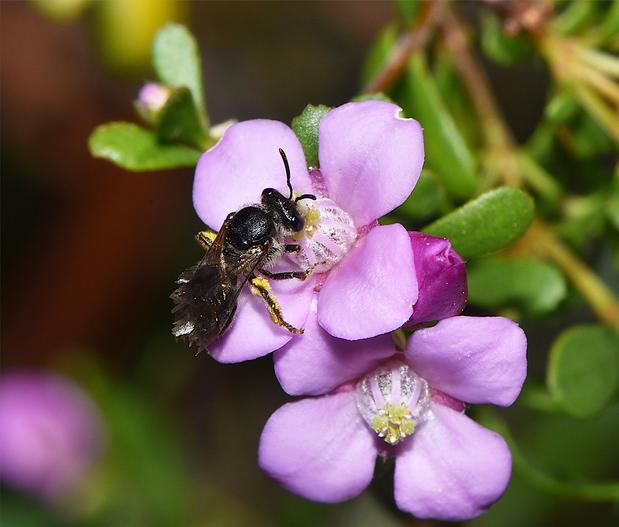Aniseed Boronia
(Boronia crenulata)
Aniseed Boronia (Boronia crenulata)
/
/

kate brown
CC BY 2.0
Image By:
kate brown
Recorded By:
Copyright:
CC BY 2.0
Copyright Notice:
Photo by: kate brown | License Type: CC BY 2.0 | License URL: https://creativecommons.org/licenses/by/2.0/ | Uploader: katebrown382 | Publisher: Flickr


































Estimated Native Range
Summary
Boronia crenulata, commonly known as Aniseed Boronia, is an evergreen subshrub native to the sandy and rocky soils of coastal heathlands and open woodlands in Western Australia. It typically grows to a height of 0.25–1.2 m (0.8–4 ft) with a similar spread, and features open, somewhat trailing branches that may intertwine with neighboring plants. The leaves are small, rounded, and crenulate (scalloped edges), emitting a distinctive aniseed scent when crushed. From late winter to autumn, it produces an abundance of pink to purple-red, four-petalled flowers that are both delicate and showy, appearing singly or in small clusters at the ends of stems or in leaf axils.
Aniseed Boronia is valued for its aromatic foliage and attractive flowers, making it a popular choice for sensory gardens and as a specimen in mixed borders. It is also used in cut flower arrangements due to its long-lasting blooms. While it prefers well-drained sandy or loamy soils, it can tolerate a range of soil types if drainage is adequate. It requires protection from strong winds and benefits from mulching to maintain soil moisture. Regular pruning after flowering helps maintain its shape and encourages denser growth. Aniseed Boronia can be susceptible to root rot if overwatered and may be affected by borers or scale insects. It is not typically invasive when grown outside its native range but should be monitored to ensure it does not become a problem.CC BY-SA 4.0
Aniseed Boronia is valued for its aromatic foliage and attractive flowers, making it a popular choice for sensory gardens and as a specimen in mixed borders. It is also used in cut flower arrangements due to its long-lasting blooms. While it prefers well-drained sandy or loamy soils, it can tolerate a range of soil types if drainage is adequate. It requires protection from strong winds and benefits from mulching to maintain soil moisture. Regular pruning after flowering helps maintain its shape and encourages denser growth. Aniseed Boronia can be susceptible to root rot if overwatered and may be affected by borers or scale insects. It is not typically invasive when grown outside its native range but should be monitored to ensure it does not become a problem.CC BY-SA 4.0
Plant Description
- Plant Type: Shrub
- Height: 2.5-3 feet
- Width: 2.5-3 feet
- Growth Rate: Moderate
- Flower Color: Pink
- Flowering Season: Winter
- Leaf Retention: Evergreen
Growth Requirements
- Sun: Full Sun, Part Shade
- Water: Medium
- Drainage: Medium
Common Uses
Bank Stabilization, Border Plant, Low Maintenance, Potted Plant, Salt Tolerant, Showy Flowers
Natural Habitat
Coastal heathlands and open woodlands in Western Australia
Other Names
Common Names:
Scientific Names: , Boronia crenulata, Boronia crenula, Boronia crenulata var. crenulata, Boronia crenulata var. typica, Boronia viminea, Boronia viminea var. latifolia,
GBIF Accepted Name: Boronia crenulata Sm.